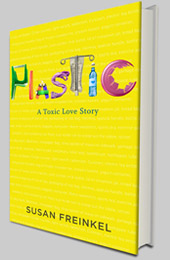There’s a fascinating report in Naturenews this week on how marine bacteria are dealing with the bazillions of pieces of plastic debris that now float in the sea, like a vast microscopic armada. The bacteria seem to be eating the plastic, though whether they are absorbing toxins the plastic may contain or just passing it up the food chain is still unclear.
Tracy Mincer, a marine microbiologist at the Woods Hole Oceanographic Institution, examined bits of plastic debris pulled from the Sargasso Sea — a “garbage patch” in the north Atlantic similar to the one in the north Pacific where ocean currents cause debris to accumulate. An expedition to the region last year found more than 48,000 pieces of plastic. Mincer examined bits of debris — plastic fishing line, a plastic bag and a pre-production pellet — and found that each was “an oasis, a reef of biological activity.” Looking at the bits through a powerful electron microscope, Mincer found bacteria-like cells living in pits in the plastic, as if they chewed had away the surface to carve out little burrows. Mincer said this is the first evidence of marine microbes breaking down plastic in the ocean.
Yet, while the bacteria may be eating the plastic, it’s not clear what they’re doing with chemical toxins that may be contained in the plastic. These microbits not only contain chemicals from manufacture, but also sop up pesticides, PCBs and other persistent chemicals that are present in the ocean.
Mincer presented his findings at the 5th International Marine Debris Conference in Hawaii last week, which concluded with the drafting of the “Honolulu Strategy,” a call to arms for governments, businesses, non-profits and citizens around the world to really tackle the problem of plastic pollution.
Reading about Mincer’s work made me think of two interviews I did while researching my book. One was with a plastics industry veteran who presents himself as an expert in sustainability. “The problem,” he said, “is that bottle caps float.” If only they sank, no one would be worrying about plastic pollution in the ocean. Out of sight, out of mind, and, as far as he was concerned, caps resting at the bottom of the sea posed no threat and would have no effect on the ocean’s ecology. His way of thinking doesn’t even consider the possibility of impacts occuring at the microscopic level.
The other was an interview I did with another marine microbiologist, David Karl of the University of Hawaii, who has looked at plastic debris in the Pacific Ocean. He too has found all those scraps of plastic are a magnet for many of the microscopic critters — from bacteria to phytoplanktom — floating in the ocean. And he has found that the plants that find a landing spot on this plastic flotsam are copious producers of oxygen, producing even more than is normally produced in the open ocean. When I talked to Karl last year, he speculated that plastic debris may be “improving the efficiency of the ocean to harvest and scavenge nutrients and produce food and oxygen.”
This isn’t to minimize the seriousness of plastic pollution in the ocean or its often devastating effects on marine wildlife. But the ecology of the ocean is also incredibly complex and the arrival of these vast amounts of synthetic materials will inevitably have a complicated impact — sometimes unforseen and even unforeseeable — that can’t be easily reduced to “it’s good” or “it’s bad.” In order to deal with the problem we need to understand all the ways plastic pollution is affecting the health of our oceans.



